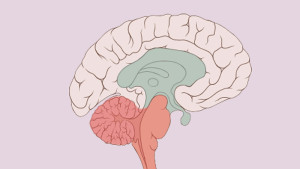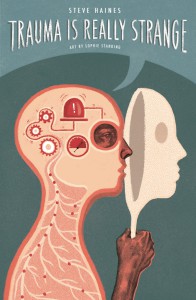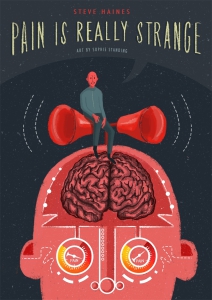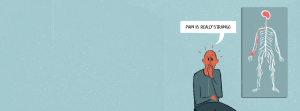Alex Demetris is an illustrator, cartoonist and maker of comics. He completed an MA in Illustration in 2012, which resulted in a comic based on his family’s experience of coping with his father’s dementia: Dad’s Not All There Any More – A Comic About Dementia. Here he shares a little about the process of creating the comic and some of his pre-publication sketches (click to enlarge the images). Alex also co-authored Grandma’s Box of Memories: Helping Grandma to Remember. Continue reading
Graphic Novels and Comics
The Thinking Behind ‘Take it as a Compliment’
Bringing together the voices of males and females of all ages, the stories in this collective graphic memoir, Take it as a Compliment, reflect real life experiences of sexual abuse, violence and harassment. In this blogpost, Maria Stoian explains the thinking behind this important graphic memoir, published by Singing Dragon.
Before I can talk about Take it as a Compliment, I feel I should introduce the project which preceded it. It was a short comic called The Elephant in the Room, which I made during my undergraduate degree. It was a fictional story exploring how the trauma of sexual assault might affect a person’s perception of reality and how they might deal with it in their daily life – which is to say that they probably would not talk about it, but instead bottle it up.
The project ended up being something I talked about all the time, and, as a consequence, the subject of sexual violence came up frequently. One day, I mentioned a comment I had read online which said, “When I finally plucked up the courage to tell my mother about my rape, the first thing she did was ask me what I was wearing.” I thought this was a horrifying response, in its words and also in how common the sentiment it expressed is. Instead of being appalled, however, one of the girls I was with said, “Well, a woman is responsible for her dignity.”
I couldn’t believe that the testimony of this girl wasn’t enough to convince this girl – that it didn’t say enough. I thought, “This happens to so many people, how have you missed this?”
The much more common response to my project was that people started sharing their stories with me. There was a lot of, “Oh, this happened to me too” or, “This reminds me of something else I’ve experienced” or, “I haven’t talked about this before, but now i feel like I can.””
All this made me think that if I were to draw up all these stories and put them in a book, it would speak to people when they read it. It would speak to them so loudly, and so clearly that it couldn’t be ignored by people who thought that the source of the problem was women’s lack of “dignity.”
When I started collecting stories, it was definitely a group effort. I didn’t have a very prominent web presence, so my friends helped me get the ball rolling when they told their friends about the project, and when the feminist society at uni posted a link sending people to the project’s blog, that was a huge help as well. I ended up with anonymous Tumblr messages, emails, and even a few interviews.
 Each story is stylistically a bit different as a result of each voice being different. I received stories that were several pages long, and some that were only a couple of sentences. There are chapters where the narration is there, word for word, and there are also stories that only include dialogue. I found the responsibility of telling the story as truthfully as possible – often without knowing the protagonist – to be a bit difficult. Some people were very frank about what had happened to them, to the point where they were just recalling a series of events. Others talked about how they felt, and that was when I had to decide whether to show it, or use their words.
Each story is stylistically a bit different as a result of each voice being different. I received stories that were several pages long, and some that were only a couple of sentences. There are chapters where the narration is there, word for word, and there are also stories that only include dialogue. I found the responsibility of telling the story as truthfully as possible – often without knowing the protagonist – to be a bit difficult. Some people were very frank about what had happened to them, to the point where they were just recalling a series of events. Others talked about how they felt, and that was when I had to decide whether to show it, or use their words.
I also thought a lot about how I would be designing the characters. I had never met most of the people who shared their stories with me, and the people I did know needed to not look like themselves, while still being themselves. I didn’t want the audience to read the characters incorrectly; I wanted to convey the sense that they were all just everyday people.
To make a point about how I was thinking about the problem, I simplified it in a little exercise for my classmates. I made a small activity book and among the questions I had prepared, I asked the readers to make judgements about the characters I drew, to assign personalities to them, and to label them as heroes or villains. The idea was that, in real life, there are no guaranteed visual signs for what a person is like, and any interpreted signs are based on what we have been taught by culture and the media. The responses I got were that it was difficult to say which character was what, because they all appeared neutral – and yet there were clear patterns in how people judged the faces. After I explained, “Of course they just look neutral, that’s what real life is like, that was the point.” I was advised to draw the characters more “good” or “bad.”
The frustration that people felt when the characters didn’t fit into neat two-dimensional boxes was something I thought might come out of Take it as a Compliment. While I wanted each story to have its own individuality, and show each character’s humanity, I also wanted it to have a certain level of neutrality, a sense of this individual human being and their unique experience being one of many. I learned that statistics didn’t say as much to people as I thought they would. It seemed everyone already knew the 1 in 6, 1 in 4, 1 in 3 estimates from this study and that one. Somehow it wasn’t enough, it didn’t translate perfectly that the 1 was a human being. And equally, that what happened to them was caused by another human being. Survivors and perpetrators of sexual violence are real, everyday people.
As it turned out, the anonymity ended up not being that important to all that many people,  what with there being interviews and emails sent. Not only did people choose to approach me without anonymity, some people even signed their names to their stories. One person introduced themselves in their written story by name, saying, “And that’s my REAL name, because these things happen to REAL people.”
what with there being interviews and emails sent. Not only did people choose to approach me without anonymity, some people even signed their names to their stories. One person introduced themselves in their written story by name, saying, “And that’s my REAL name, because these things happen to REAL people.”
All throughout its creation, I thought of Take it as a Compliment as being for two groups: For survivors and for bystanders. For the survivors, I’d hoped that the act of telling their stories would be part of a sort of healing process for them. And for bystanders, it was a message to be active in the discussion and to take action regarding the issue.
I don’t know how much personal benefit the survivors in the stories got from sharing, but it was clear that many of them did it not for themselves, but out of a concern for other people. Almost every contributor prefaced their story with something along the lines of, “People need to know this is a very real, and a very common occurrence.”
I think one of the most exciting things about the book getting published is that the survivors who did choose to remain anonymous have a chance to see that it became a real thing, and that it’s part of a conversation. Before Take it as a Compliment was picked up by Singing Dragon, it really was just all the stories, back to back. That was the main thing that needed to change. The publisher really felt – and I agree – that there needed to be a conclusion. A lot of people might get through the book and feel a lot of anger, and rightfully so. They might also feel helpless. But there is a lot of power in the discussion. There are a lot of us out there who are aware of the issues and who are eager to make changes.
My hopes for Take it as a Compliment going forward would be for it to keep doing what it’s been doing, which is to keep the conversation going. Even after the project was finished, and it was on display at my university’s grad show, I was approached by an older woman who said, “I really connected with your project because I’ve also been raped. Thank you.”
When we stand up and talk about these experiences, we can make more of an impact together, than we can by suffering in silence on our own.
Maria Stoian is a graphic designer and illustrator based in Scotland. She is interested in the way illustration and games can be a non-aggressive way of encouraging people to recognise when they might be biased. Take It As A Compliment was Maria’s Master’s project at Edinburgh College of Art.
 Take it as a Compliment by Maria Stoian is AVAILABLE NOW
Take it as a Compliment by Maria Stoian is AVAILABLE NOW
Price: £14.99
ISBN: 978-1-84905-697-7
Memory in Trauma by Steve Haines
In this article, Steve Haines shares his thoughts on memory and trauma, and how important it is to recall past memories. Steve Haines is the author of medical graphic book Pain is Really Strange. His new book Trauma is Really Strange will be available on the 21st December.
Some Thoughts On Memory
Where are memories stored? In order to heal trauma, how important is it to remember what happened? These are common questions that often come up working with clients and teaching on trauma.
There are folklore phrases such as ‘muscle memory’ and ‘cellular memory’ that can be very useful but need to be applied carefully. They speak to the importance of information stored in the body. However it is essential to understand that for the information to be available to our awareness, our brain needs to be involved in processing the patterns of information flow happening in the body. Where the information is processed – in the primitive brain (unconscious) or in the cortex (conscious) – determines whether or not the memory is explicit.
I have a favourite old pair of jeans right now, some holes are on the second round of stitching. The wrinkles and folds in the material are a memory of sorts, the jeans mould to my body like no other pair of trousers. The fascia researcher Gil Hedley (2005) talks about fascia as ‘fuzz’. The fuzz accumulates and represents time. A certain stickiness and alignment of the fibres in the tissues holds the joints in more habitual ways.
Imagine a small child being shouted out by her father. Her shoulders tense, her neck tightens and there is a surge of fear related hormones and activity in the body. If this happens continuously the pattern of ‘shoulders tense and neck tight’ becomes a deep ‘action pattern’ (Kozlowska et al 2015).
Now imagine 30 years later the adult is on your treatment table. With grounded presence and soft, safe, warm, hands you are holding her head and neck. The tissues in her neck begin to express long held contractions and tightness. A shape in her body emerges, similar to the pattern generated when she got shouted at. Your client begins to feel unease and may think about her father.
The ‘muscle memory’ is the tension and tone in the tensegrity of the neck (Ingber 2008). The ‘cellular memory’ is cellular membrane receptors on local and global cells that grew to be sensitive to the all the stress hormones, immune system signaling and inflammatory chemicals that used to be secreted in the fear response (Damasio and Carvalho 2013). The ‘action patterns’ are simple, default movement schemas held in the old primitive brain.
Sensory nerves signal the changes in tension and chemical milieu to the brain. Only with the brain involved do we have emotions, feelings and thoughts generated in awareness. They may or may not be fully integrated into cognition, but something is happening. A memory is being expressed.
Instead of explicit memories we can have implicit memories (I first heard this term from Babette Rothschild, 2000), here the activation is chiefly in the primitive brain (brain stem, cerebellum and limbic system). The client on the table becomes scared when you touch her neck and too much changes too soon, but she does not really know why she is getting upset.
As a therapist working with trauma it is important to note the surges and changes in the rhythmic activity of the body as implicit memories occur. There are some great early warning signals that something is happening.
We can then help find the right pace of change for the individual so they can learn to self-regulate. The therapist’s skillful presence can lead to co-regulation such that the individual can learn to self-regulate (Ndefo 2015). The primitive brain does not do words and concepts very well, but will respond to safety, touch and presence.
Implicit memories are coded very simply in the primitive brain. Often they are without a timeline. The amygdala – an important part of our threat detection system (LeDoux 2015) – holds lots of symbolic representations of threat. The amygdala will trigger ‘fight-or-flight’ or ‘immobility’ responses (‘defense cascade’ Kozlowska et al 2015) if it senses danger in the incoming information stream.
If the cortex gets involved then we will have explicit memory – we can pull in associated events and a timeline to contextualise the activity in the body. Explicit memories usually only emerge into awareness after the body has changed. The hippocampus and prefrontal cortex should help us say ‘That happened 30 years ago’. The skill of the therapist here is to honor the memories and stories that appear but keep orienting the client to resources in the body and environment; ‘Its not happening now’, even if your body is screaming at you be scared.
Following Dr David Berceli (2008), founder of Trauma Releasing Exercises (TRE), I am fond of saying ‘You do not need to remember or do not need to understand to heal trauma’. The goal is to overwrite the symbols in the amygdala with present time information. The body is a great source of good news that can bring you into now.
Summary
Information is stored in the tissues and cells of the body.
The threat detection systems in the primitive brain can be activated as the body changes.
The primitive brain does not do words and concepts very well, but will respond to safety, touch and presence.
If we can support change in the body and down regulate arousal we can change memories with out needing to understand or remember the trauma event.
The goal is to uncouple the charge of the defense cascade from the sensations of the implicit memory.
Notes
1 Kozlowska et al (2015) list some early signs of arousal. For flight-or-fight (their preferred order of this phrase) they list; changes in breath, furrowing of the eyebrows, the tensing of the jaw, or the clenching of a fist, narrowing of the range of attention. For immobility states they list; visual blurring, sweating, nausea, warmth, light-headedness, and fatigue.
My favourite signs to look out for are anything going too quick (thoughts, sensations or emotions that cannot be integrated into the present moment) and anything going too slow (spacey, floaty, absence, hard to make eye contact, numbness or tingling or loss of body awareness).
Dry mouth, sense of small or far away feet, absent belly, cold hands and a sense of someone withdrawing are all good signs to put the brakes on, whatever process is being expressed. David Berceli teaches ‘Freezing, Flooding or Dissociation’ as signs that too much arousal is occurring.
Download as pdf: memory v3 2015-10-29
References
Berceli D (2008) The Revolutionary Trauma Release Process. Transcend Your Toughest Times. Vancouver: Namaste Publishing.
Damasio A and Carvalho GB (2013) The nature of feelings: evolutionary and neurobiological origins. Nature Reviews Neuroscience, Vol 14, February 2013, 143.
Hedley G (2005) The Integral Anatomy Series. 4 Vol DVD set. Integral Anatomy Productions, LLC, 430 Westwood Avenue, Westwood, NJ 07675, USA (or check ‘The Fuzz Speech’ on YouTube).
Ingber DE (2008) Tensegrity and mechanotransduction. Journal of Bodywork and Movement Therapies 12, 198–200.
Kozlowska K, Walker P, McLean L, and Carrive P (2015) Fear and the Defense Cascade: Clinical Implications and Management. Harv Rev Psychiatry. 2015 Jul; 23(4): 263–287.
LeDoux JE (2015) The Amygdala Is NOT the Brain’s Fear Center. psychologytoday.com http://bit.ly/ledoux-no-fear-center Accessed 2015-09-01
Ndefo N (2015) Personal communication. www.trelosangeles.com ‘Sometimes we have to co-regulate before we can self-regulate’.
Rothschild B (2000) The Body Remembers – The Psychophysiology of Trauma and Trauma Treatment. London: W.W. Norton.
Medical graphic books by Steve Haines, published by Singing Dragon
Pain is Really Strange is a scientifically-based, detailed, and gently humorous graphic book on pain and pain management. Answering questions such as ‘how can I change my pain experience?’, ‘what is pain?’, and ‘how do nerves work?’, this short research-based graphic book reveals just how strange pain is and explains how understanding it is often the key to relieving its effects.
Trauma is Really Strange is a science-based medical graphic book explaining trauma, its effects on our psychology and physiology, and what to do about it. When something traumatic happens to us, we dissociate and our bodies shut down their normal processes. This unique comic explains the strange nature of trauma and how it confuses the brain and affects the body. With wonderful artwork, cat and mouse metaphors, essential scientific facts, and a healthy dose of wit, the narrator reveals how trauma resolution involves changing the body’s physiology and describes techniques that can achieve this, including Trauma Releasing Exercises that allow the body to shake away tension, safely releasing deep muscular patterns of stress and trauma.
Trauma is Really Strange will publish on December 21st 2015.
Drawing and Writing about Anxiety
When Anxiety Attacks is a graphic memoir about living with anxiety and finding help through a therapist. In this blog, Terian Koscik, author and illustrator, gives an inside look to her experience of drawing and writing about anxiety.

One of the hardest parts about living with anxiety is trying to explain what it’s like to friends and family who don’t experience it. To them, it makes no sense that someone who is usually capable of making clear, rational decisions would have fears and thoughts that are totally irrational. What they don’t realize is that anxious people are often perfectly aware of how irrational our thoughts are. This doesn’t make it any easier to ignore them, though. Dealing with anxiety, beginning to understand it after going to therapy for the first time, and trying to convey my new sense of understanding to others led me to want to create a comic book about the experience.
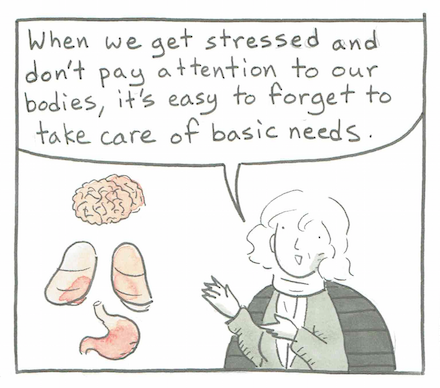
As a child, my anxieties appeared blatantly silly and irrational to outside observers. I would panic whenever the phone rang, worried about what would happen if we didn’t answer it before it went to voicemail. What if it was an extremely important call, and they needed to talk to us right then? Or what if they thought we didn’t care?
As adults, we have a lot more in our lives to worry and panic about, and the line between what is silly and what isn’t is harder to see, especially if one’s default state is to worry. After graduating from college, my best friend from high school moved in with me, and I was distraught when she didn’t seem as enthusiastic about living together as I was. I constantly thought about what I was doing wrong when she chose to spend her time alone instead of with me, and whether I was capable of making any friends at all. I ended up going to therapy to talk about these feelings. I gradually realized that my worries were based on a general fear of being alone rather than anyone’s specific actions, that I could address them directly by asking others for help, and that there was nothing wrong with me for feeling this way.
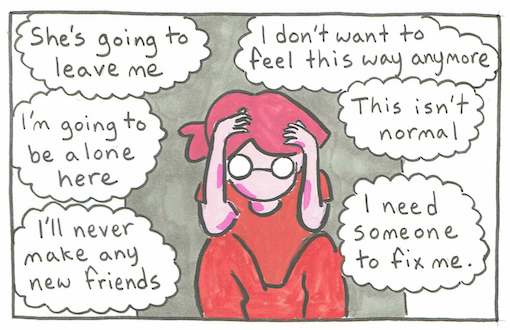
In my book “When Anxiety Attacks,” I used dramatically different color palettes to demonstrate the way that irrational anxious thinking separates one from their usual ability to consider facts and possibilities. Other people and possibilities other than the worst case scenario do not exist in this state of mind. This makes it difficult or impossible for well-meaning loved ones to get through to us when in this state. For example, if I felt lonely, someone might remind me that I have many friends and family to turn to for reassurance. However, my anxious thinking would find a way to ignore this advice. Wouldn’t my friends and family have more important things to do than listen to me complain? Did I even deserve their attention?
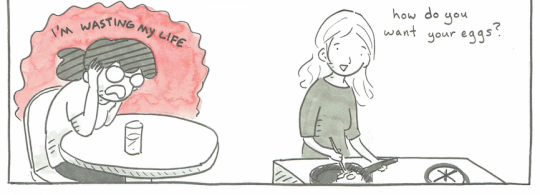
Through therapy I have found that as anxious people, the best we can do is remain open to facts and possibilities, and not judge ourselves too harshly for the tendency to worry. I hope that my book will help others reach this conclusion.
Terian Koscik has been a reader of comics, a creator of comics, and an anxious person for almost as long as she can remember. Most of her work is autobiographical in nature, and deals with finding humor in feelings of loneliness, anxiety, and depression. She posts her work regularly at http://pineconedoesthings.tumblr.com/. Terian lives in Portland, Oregon with 4 humans and 2 rabbits.
Tweet in a drawing of your anxious self to @Singing_Dragon_ using the hashtag #AnxiousMe to enter the chance to win a copy of When Anxiety Attacks
Learn more about When Anxiety Attacks here
Sign up to receive the Singing Dragon Complete Catalogue
 The Singing Dragon Complete Catalogue is now available. With full information on our expanding list of books in Chinese Medicine and Acupuncture, Qigong, Yoga, Aromatherapy, and a variety of other disciplines, our catalogue is an essential resource for complementary health practitioners and anyone interested in enhancing their own health, wellbeing and personal development.
The Singing Dragon Complete Catalogue is now available. With full information on our expanding list of books in Chinese Medicine and Acupuncture, Qigong, Yoga, Aromatherapy, and a variety of other disciplines, our catalogue is an essential resource for complementary health practitioners and anyone interested in enhancing their own health, wellbeing and personal development.
To receive a free copy of the catalogue, please fill out the form below and press subscribe:
One Year Wiser – Guest post for Singing Dragon
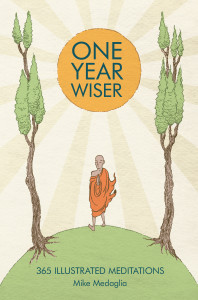 This month we would like to host a guest blog post by Mike Medaglia. Mike is a comic artist and illustrator with a brand-new comic book, One Year Wiser: 365 Illustrated Meditations, published by SelfMadeHero. Mike is also known at JKP and Singing Dragon for his invaluable contribution as an art editor and project manager on a bunch of new exciting comics projects. Enjoy!
This month we would like to host a guest blog post by Mike Medaglia. Mike is a comic artist and illustrator with a brand-new comic book, One Year Wiser: 365 Illustrated Meditations, published by SelfMadeHero. Mike is also known at JKP and Singing Dragon for his invaluable contribution as an art editor and project manager on a bunch of new exciting comics projects. Enjoy!
Hello and welcome! My name is Mike Medaglia and I am an editor at Jessica Kingsley Publishers. I am also a comics artist and have been helping develop a line of comics for both JKP and Singing Dragon.
On September 9th I have a book of my own coming out called One Year Wiser: 365 Illustrated Meditations. It is a one a day book with a quote from a writer, artist or thinker that has been adapted into a full page illustration. It is published by SelfMadeHero, an independent comics publisher, and will be available in the US, Canada and the UK. All the quotes for the images were chosen because they have messages of positivity, hope, encouragement and love.
I have been working on this book for the past year and posted an image online every Monday since January. You can see them all here.
One Year Wiser is also available as a colouring book. With the illustrations already having a reflective tone to them, it seemed natural to adapt the images so they could be used for colouring in. Adult colouring books have grown in popularity recently. There is something so relaxing about pulling out your crayons or markers and getting back to the simple act of colouring in. It brings back days from childhood and is also a chance to do something tactile and creative and to take a break from endlessly staring at a screen.
My work at Jessica Kingsley Publishers and Singing Dragon
Now, to say a bit more about my role here at JKP, I have been working since January as an art editor and project manager on a bunch of new comics projects. We are taking topics that JKP and Singing Dragon are well known for and are using the medium of comics to explore them in a new way.
Our first release was Pain Is Really Strange, written by Steve Haines and illustrated by Sophie Standing. It is a research-based comic that looks at how strange pain is and how understanding it can often be the first step to relief. It did, (and it’s still doing!), extremely well and its publication made us both excited and proud.
And at the end of this month we are also very excited to be publishing When Anxiety Attacks by Terian Kosick. It is a personal account by Terian of coming to terms with her anxiety and how she eventually chose to seek therapy as a way of coping with it. It is as funny as it is informative and a perfect introduction to the different options available to help manage anxiety.
We have some more really great comics projects in the pipeline that are set to be released over the coming months. Comics is such a diverse art form and I am so excited to be able to help work on books with JKP and Singing Dragon that use comics to discuss such important topics!
If you want to find out more about Mike and his work visit his website http://mikemedaglia.com/
For more on Singing Dragon and JKP new comics projects visit our websites http://intl.singingdragon.com and http://www.jkp.com/
A revolution in understanding pain – interview with the author of ‘Pain is Really Strange’
In this interview Steve Haines, author of Pain is Really Strange, discusses the topic of pain, he explains the reasons behind his choice to write a book about it using the graphic medium and tells us what people can do to manage pain.
Read the edited interview here:
Why do a book on pain?
There’s an awful lot of pain around. There was a huge survey done in Europe: 1 in 5 people experience chronic pain. They have persistent or severe pain for more than six months. For many of them, the median time was a number of years.
People manage large amounts of pain. Pain is a universal human experience; everybody knows what pain is.
The really exciting news is that there is a revolution in how we understand pain. The goal of the book is to try and explain that. How pain works is actually a little bit counterintuitive, a little bit strange. Some of the things that people think cause pain actually turn out to be not quite as central as folklore would have it.
Why do a graphic book on pain?
Education is a central tool in changing pain. The goal of using images it to make it light and really accessible. A good image can communicate an argument and idea very quickly. The book emerged from lots of lectures and talks I’ve given over the years. I have been endlessly trying to find creative ways of explaining how pain works to my clients and students.
I was incredibly lucky to meet Sophie Standing. I have really enjoyed how she’s visualized the work. She surprised me sometimes about how she took an idea that I’d been familiar with for a number of years and just showed it in a very different way.
I think that graphic novels can be very powerful tools. Pain Is Really Strange is short and sweet, 36 pages, but there’s an awful lot of information packed into the book. The images try and really crystallize ideas into something simple.
Who is the book aimed at?
The book is for everybody. Everybody experiences pain, and I think everybody can learn from the new science. The current research can really help us change our idea and experience of what pain is, even really difficult chronic pain.
I would offer that everybody should be able to stand, walk, sit, and sleep, without issues. You might not be able to run a marathon anymore, and you might not have the best tennis serve that you had when you were in your 20s, but ordinary movements of sitting, standing, walking, lifting your shopping; it’s actually often possible to get people to a place where they can do those everyday functions with ease reasonably quickly. That makes a huge change in happiness and vitality
What is the central message of the book?
There is something that you can do to change your pain experience. There’s always a change in behaviour, a change in how you think, feel, move that can be used to creatively stimulate your brain to do something different.
The really central message is: think of pain as a bad habit or an alarm system that has gone wrong. Short-term it was very useful, but long-term chronic pain serves very little purpose. We can unlearn the pain habit. We can train our nervous system to respond differently to the information that’s coming in.
What is the hardest thing to explain about pain?
By saying: “Pain involves the brain,” people often feel that you’re saying that it’s their fault. That’s really not what I am saying. I like to talk about the mind, the brain, and the body. The mind is our consciousness, our awareness, our sense of self. The brain is in between the mind and the body. Pain is an output from the nervous system, not an input.
The brain can make mistakes. It gets into habits or reflexes. Evolution has taught us to respond to the threat of danger very, very quickly, and sometimes in those quick responses, we go down fixed, hard-wired, old patterns that are hard to break out of. But, and this is the important bit, reflexes and habits are responsive to new learning; we can learn to respond differently.
There’s no one answer to pain. For me that’s very exciting, but it can feel overwhelming and confusing. It implies that creativity, learning to do things differently, is possible. A complex nervous system will benefit from a multitude of responses. Culture, society, family, stress, how we eat, emotion and metabolic activity in our body are all deeply relevant to the pain experience.
What can people do to manage pain?
Mostly, it’s about being creative. Do something different. Whatever you’ve been doing, if you’re still in pain, it’s not working. Try a new approach. We can move differently, understand differently, feel differently, describe ourselves differently. The book explores some simple hints about how we might do those things, but the essence is change and creativity in response to the danger signal, and not going down fixed, hard-wired responses.
Understand that reflexes that were useful when you really needed to protect the tissues as they repaired are no longer useful after the tissues have repaired. Tissue repair takes no more than a few months. In chronic pain the nervous system needs recalibrating.
For me, the book is a very hopeful book; there is something you can do to change your pain experience. Pain isn’t about tissues. It’s about an alarm system in the nervous system that’s exaggerated and is no longer accurate about the state of the tissues.
Steve Haines, June 2015
Or listen to the full interview here. Linda from Singing Dragon asked Steve Haines some questions…
Steve Haines has been working in healthcare for over 25 years and as a bodyworker since 1998. He is the co-author of ‘Cranial Intelligence’ and author of the short graphic books ‘Pain Is Really Strange’ and ‘Trauma Is Really Strange’. Understanding the science of pain and trauma has transformed his approach to healing. He has studied Yoga, Shiatsu, Biodynamic Craniosacral Therapy, and Trauma Releasing Exercises (TRE). He is a UK registered Chiropractor and teaches TRE and Cranial work all over the world. His treatments now use education, embodied awareness and light touch to help people move more freely and be more present. Steve lives and works between London and Geneva.
Treatments: www.stevehaines.net Teaching TRE: www.trecollege.com Teaching Cranial: www.bodyintelligence.com Graphic Books: www.painisreallystrange.com
Call for Comic and Graphic novel submissions
Singing Dragon and Jessica Kingsley Publishers have recently started developing an exciting new line of comics and graphics novels and we are now open for submissions.
Singing Dragon publishes authoritative books on all aspects of Chinese medicine, yoga therapy, aromatherapy, massage, Qigong and complementary and alternative health more generally, as well as Oriental martial arts. Find out more on intl.singingdragon.com
JKP are committed to publishing books that make a difference. The range of subjects includes autism, dementia, social work, art therapies, mental health, counselling, palliative care and practical theology. Have a look on www.jkp.com for the full range of titles.
If you have an idea that you think would work well as a graphic book, or are an artist interested in working with us, here is what we are looking for:
Graphic novel or comic – Long form
We are looking for book proposals that are between 100 and 200 pages, black and white or colour, and explore the topics listed above or another subject that would fit into the JKP/Singing Dragon list. Specifically we are hoping to develop more personal autobiographical stories.
Here are the guidelines for submission:
- A one-page written synopsis detailing the plot/outline of the book, as well as short bios of all the creators involved.
- Character sketches of the main characters with descriptions.
- Solo artist/writers or writer and artist teams should submit 5 to 10 completed pages to allow us to get a sense of the pace, art style and writing.
- Solo writers will need to submit 10 to 20 pages of script as well as the one-page synopsis from point 1.
Comic – Short form
We have some shorter comic projects underway and are looking to expand the range of topics covered. These books can run from 20 to 40 pages, black and white or colour, with dimensions of 170x230mm. We are mainly looking for comics that provide ideas and information for both professionals and general readers.
For example, the first in this series, published by Singing Dragon, is a book exploring the latest developments in chronic pain research.
Here are the guidelines for submission:
- A one-page written synopsis detailing the narrative style and subject matter to be explored in the book. Also include short bios of all the creators involved.
- Solo artist/writers or writer and artist teams should submit 3 to 5 completed pages to allow us to get a sense of the pace, art style and writing.
- Solo writers will need to submit 5 to 10 pages of script as well as the one-page synopsis from point 1.
When submitting please provide low-res images and send them, along with everything else, to Mike Medaglia at mike.medaglia@jkp.com
If you have any other ideas that don’t directly relate to the subjects described above but you feel might still fit into the Singing Dragon or JKP list, please feel free to get in touch with ideas and enquiries on the email above.
Last post dates for Christmas 2014
If you would like to receive your purchases in time for Christmas 2014 we recommend placing your order before midnight on the following dates (depending on which country you want to ship to)
USA – 12th December 2014
UK – 15th December 2014
Australia – 15th December 2014
New Zealand – 5th December 2014
We regret that we cannot provide accurate dates for other countries but if you email hello@intl.singingdragon.com or call +1 215 922 1161 (USA) or +44 (0)20 7833 2307 (UK and rest of world) we will do our best to find out for you. If you miss the last post dates it may be possible to express deliver your order, please call or email to find out.
Have a merry Christmas and a happy New Year from everyone at Singing Dragon!
Singing Dragon New and Bestselling titles Autumn-Winter 2014 and 2015
This fully interactive brochure has all of the new Singing Dragon titles for the Autumn and Winter of 2014 as well upcoming titles for 2015. In here you will find books on Chinese medicine, complementary therapies, martial arts, nutrition, yoga, ayurveda, qigong, Daoism, aromatherapy, and many more alternative therapies and ancient wisdom traditions.
Click on the covers or titles to be taken to the book’s page on the Singing Dragon website. If you would like to request hard copies please email hello@intl.singingdragon.com with your details and the number of copies you would like.
